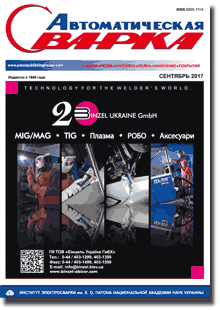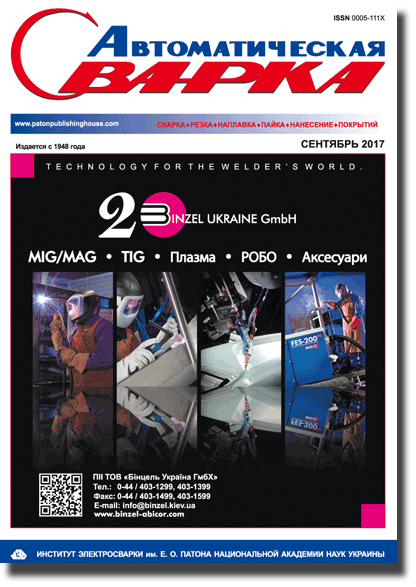| 2017 №09 (01) |
DOI of Article 10.15407/as2017.09.02 |
2017 №09 (03) |

Avtomaticheskaya Svarka (Automatic Welding), #9, 2017, pp. 10-16
Investigation of physical features and technological capabilities of continuous optical discharge
V.D. Shelyagin, A.V. Bernatsky, V.Yu. Khaskin, I.V. Shuba and A.V. Siora
E.O. Paton Electric Welding Institute, NASU 11 Kazimir Malevich Str., 03150, Kiev, Ukraine. E-mail: office@paton.kiev.ua
Abstract
In order to study physical features and technological capabilities of continuous optical discharge, a number of laboratory stands and plasmatrons were developed, which were used to determine the ranges of variation of energy, gas-dynamic, chemical and design parameters, providing stability of processing operations. It was found that at the change of power of CO2-laser radiation in the range of 1.5–6.0 kW, power of continuous optical discharge changes linearly, while power of laser radiation, passing through the discharge, can be regulated from 8 to 40 % of CO2-laser radiation power. Shown is the possibility of additional energy input into continuous optical discharge from direct current source. Here, power of additional input can exceed that of laser radiation. It is rational to apply continuous optical discharge, together with laser radiation which passed through it, to produce new materials, nanostructured carbide and diamond films, spheroidizing of refractory materials, surface modification, surfacing and other related technologies. 14 Ref., 1 Table, 3 Figures.
Keywords: continuous optical discharge, CO2-laser radiation, surfacing, heat treatment, experiments, modes, metallography, structure, residual stresses
Received: 16.05.17
Published: 10.10.17
References
- Generalov, N.A., Zimakov, V.P., Kozlov, G.I. et al. (1971) Experimental investigation of continuously burning optical discharge. ZhETF, 61(1), 1434–1446.
- Kozlov, G.I. (1978) Laser plasmatron with gas flow. Pisma v ZhETF, 10(4), 586–589.
- Raizer, Yu.P. (1980) Optical discharges. UFN, 132(3), 549–581. https://doi.org/10.3367/UFNr.0132.198011e.0549
- Zimakov, V.P., Kuznetsov, V.A., Kedrov, A.Yu. et al. (2009) Gas laser for efficient maintenance of plasma of continuous optical discharge in scientific and technological applications. Kvantovaya Elektronika, 39(9), 797–801. https://doi.org/10.1070/QE2009v039n09ABEH014063
- Bolshakov, A.P., Kono, V.I., Vostrikov, V.G. et al. (2008) Examination of plasma optical discharge in multicomponent mixtures of molecular gases. Ibid., 38(2), 165–168.
- Zimakov, V.P., Kuznetsov, V.A., Kedrov, A.Yu. et al. (2009) Refraction of laser radiation in plasma of continuous optical discharge in gas flow at atmospheric pressure. Optika Atmosfery i Okeana, 22(11), 1023–1028.
- Franzen, D.L. (1973) Continuous laser-sustained plasmas. Appl. Phys., 44, 4, 1727–1732. https://doi.org/10.1063/1.1662439
- Kozlov, G.I., Kuznetsov, V.A., Masyukov, V.A. (1979) Continuous optical discharge in molecular gases. ZhTF, 49(11), 2304–2310.
- Bolshakov, A.P. (2007) Synthesis of polycrystalline diamond films using laser plasmatron: Syn. of Thesis for Cand. of Phys.-Mat. Sci. Moscow: RGB.
- Raizer, Yu.P. (1996) Continuous optical discharge — maintenance and generation of dense low-temperature plasma by laser radiation. SOZh, 3, 87–94.
- Kolumbaev, E.B., Lelevkin, V.M. (2002) Numerical analysis of characteristics of optical discharge in air. Vestnik KRSU, 2(2), 76–83.
- Shelyagin, V.D., Krivtsun, I.V., Borisov, Yu.S. et al. (2005) Laser-arc and laser-plasma of welding and coating technologies. The Paton Welding J., 8, 44–49.
- Borisov, Yu.S., Khaskin, V.Yu., Vojnarovich, S.G. et al. (2012) Combined laser-microplasma cladding with powders of Ni–Cr–B–Si system alloys. Ibid., 11, 16–22.
- (1992) Physical encyclopedia. Moscow: Great Russian Encyclopedia.
The cost of subscription/purchase order journals or individual articles
| Journal/Currency | Annual Set | 1 issue printed |
1 issue |
one article |
| TPWJ/USD | 384 $ | 32 $ | 26 $ | 13 $ |
| TPWJ/EUR | 348 € | 29 € | 24 € | 12 € |
| TPWJ/UAH | 7200 UAH | 600 UAH | 600 UAH | 280 UAH |
| AS/UAH | 1800 UAH | 300 UAH | 300 UAH | 150 UAH |
| AS/USD | 192 $ | 32 $ | 26 $ | 13 $ |
| AS/EUR | 180 € | 30 € | 25 € | 12 € |
| SEM/UAH | 1200 UAH | 300 UAH | 300 UAH | 150 UAH |
| SEM/USD | 128 $ | 32 $ | 26 $ | 13 $ |
| SEM/EUR | 120 € | 30 € | 25 € | 12 € |
| TDNK/UAH | 1200 UAH | 300 UAH | 300 UAH | 150 UAH |
| TDNK/USD | 128 $ | 32 $ | 26 $ | 13 $ |
| TDNK/EUR | 120 € | 30 € | 25 € | 15 € |
AS = «Automatic Welding» - 6 issues per year;
TPWJ = «PATON WELDING JOURNAL» - 12 issues per year;
SEM = «Electrometallurgy Today» - 4 issues per year;
TDNK = «Technical Diagnostics and Non-Destructive Testing» - 4 issues per year.





